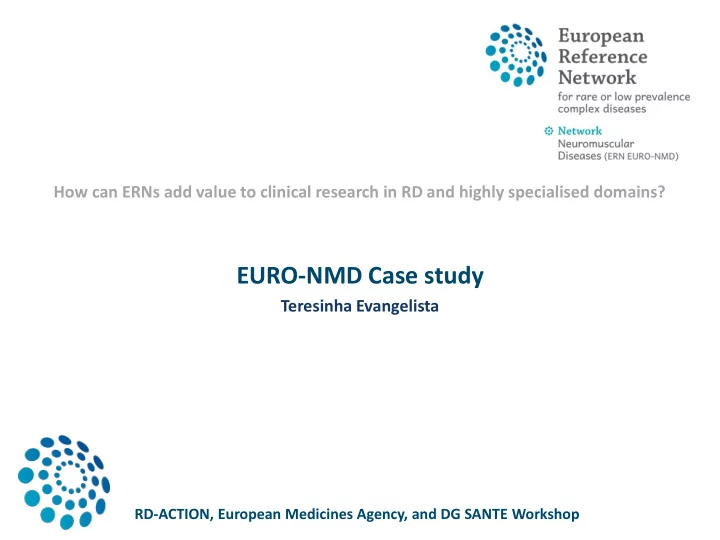

How can ERNs add value to clinical research in RD and highly specialised domains? EURO-NMD Case study Teresinha Evangelista RD-ACTION, European Medicines Agency, and DG SANTE Workshop Building bridges and breaking barriers in rare neuromuscular diseases
Building bridges and breaking barriers in rare neuromuscular diseases 2
EURO-NMD Strategic Research Plan Main goals: • Promote research activities within the network • Ensure a harmonized baseline that will enable standardization and reuse of network data and samples for research • Develop better Research Services Building bridges and breaking barriers in rare neuromuscular diseases 3
Key deliverables for the first year: • Mapping of research infrastructures and studies for NMD patients • Agreed consent elements • Agreed data sharing standards and mechanisms • Database of shared samples through deposition at biorepositories and – omics data with associated phenotypic data via submission to databases and RD-Connect Building bridges and breaking barriers in rare neuromuscular diseases 4
Building bridges and breaking barriers in rare neuromuscular diseases 5
Registries The registries were developed to: • Help researchers to answer questions such as: how common the individual diseases are • Support activities to improve patient care, such as the assessment of care standards in different countries. • Help Pharmaceutical companies interested in locating patients for a clinical trial. • Facilitate contact with Patients. Patients will be informed through their own national registry of upcoming trials Building bridges and breaking barriers in rare neuromuscular diseases 6
Building bridges and breaking barriers in rare neuromuscular diseases 7
Care and Trial Site Registry – CTSR • One of the major hurdles to overcome before initiating a clinical trial is to identifying trial sites able to recruit enough patients offer a specific standard of care offer experience in clinical trials • The concept behind the CTSR was to collect information on personnel, facilities and patient population to help industry and clinical investigators select trial sites, and to help to identify potential partners for upcoming research projects. Building bridges and breaking barriers in rare neuromuscular diseases 8
Care and Trial Site Registry – CTSR Established in 2007 It is a flexible database with the ability of being expanded with pertinent questions From 2013 includes data on NMD and Neurodegenerative diseases Registration at the CTSR was one of the specific criteria for the EURO-NMD HCPs Advantages: Real knowledge of the infrastructure of the centres Allows identification of gaps in patient care Building bridges and breaking barriers in rare neuromuscular diseases 9
Information gathered in the CTSR • General Site Information • Patient Cohorts Number of patients and available diagnostic tools • Clinical Trial Infrastructure Personnel and experience, GCP training, equipment • Care Settings Members of interdisciplinary team Arrangements for transition from paediatric to adult care Pulmonary and cardiologic care • Research and Education Participation in clinical trials Peer-reviewed publications Participation in networks Training activities Building bridges and breaking barriers in rare neuromuscular diseases 10
TREAT-NMD Advisory Committee for Therapeutics (TACT) • Established in 2009, TACT is a unique structure constituted by a multi- disciplinary international group of well recognized academic and industry drug development experts as well as representatives of patient foundations and institutional and governmental scientific research centres • Review and provide guidance on the translation and development path of therapeutics programs in rare neuromuscular diseases. Review therapeutics with the long-term goal of an intended clinical trial and potential registration. Address issues of drug formulation, bioavailability and toxicology Address possible regulatory requirements and marketing considerations. • • Provide applicants with a comprehensive written review Building bridges and breaking barriers in rare neuromuscular diseases 11
Future (EURO-NMD/TREAT-NMD) • EURO-NMD will make use of these available tools as a baseline for its clinical research activities (agreements have been established) • The remit of the disease groups of EURO-NMD is broader than in TREAT-NMD; we will work together to expand and share activities to other disease areas (funding?) • Concern: how to replicate the success of TREAT-NMD in engaging with Industry – It is a safe, ethically-sound and mutually beneficial model developed over many years… how to continue? Building bridges and breaking barriers in rare neuromuscular diseases 12
Building bridges and breaking barriers in rare neuromuscular diseases 13
Recommend
More recommend